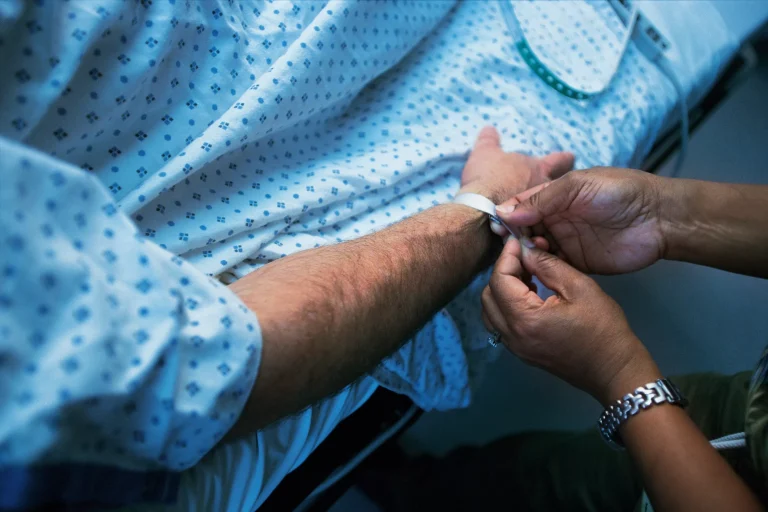Blog The Secret To Organisation In Hospitals (Psst. It’s Wristbands)

How Hospitals Use Wristbands

Aside from strong leadership, high-quality nursing and physician staff, cutting-edge technology and monitoring systems, the success of a well-run and well-organised hospital is largely determined by how effectively they communicate vital and often confidential information to medical professionals. Hospitals must communicate information to employees, patients, and visitors promptly and efficiently; it is sometimes a matter of life and death, especially in an emergency room.
Medical bracelets have long been part of how hospitals identify their patients. However, this system is evolving as more hospitals use wristbands to increase patient safety and eliminate medical errors.
This article will explain how hospital wristbands help staff and clinics manage daily operations and improve patient treatment satisfaction.
Alerting Staff
Hospital wristbands have become an important tool in increasing patient care. But also in managing visitors within the hospital. For example, wristbands quickly identify between patients and non-patients, staff and visitors. Essential distinctions are communicated simply by providing each category with a different coloured wristband. The most typical orders we receive for hospitals are for visitor wristbands. During COVID, it was critical to identify visitors who had their temperatures taken and therefore screened for COVID-19.
Identifying different groups of individuals is essential in hospital wards with security concerns and health and safety risks to consider daily. Tyvek wristbands can be used to alert staff discreetly and efficiently as to who is allowed in which hospital ward area. This is especially effective in areas where there are vulnerable individuals with extremely compromised immune systems.
We have seen several hospitals use wristbands to identify rapid antigen test (RAT) results for patients and visitors when allowing them to enter secure wards and areas of a hospital.
Communicating Vital & Important Information

Medical bracelets have long been used to communicate long-term medical conditions and requirements – diabetes and allergies, for example. As a result, medical professionals and hospital staff are trained to check patients for medical jewellery, bracelets, and wristbands that may communicate essential information about their patients.
Hospital or clinic wristbands can be printed with more in-depth information on them. One of the most popular usages we currently see with our hospital clients is wristbands to manage Covid historical cases. By this, we mean that staff can quickly highlight the Covid history of a patient to other medical professionals. Medical staff will need to interact differently with a patient in differing stages of a Covid case: has the patient had Covid recently/never/or are they currently symptomatic and awaiting results? A medical history wristband lets staff know how they need to proceed to engage with and treat the patient safely.
Hospitals will commonly put wristbands on patients with the text “DO NOT USE THIS ARM – AV – Arteriovenous Fistula” printed on to them. This signifies the patient has an irregular connection between an artery and a vein, created to allow access for dialysis access. For this reason, these wristbands are especially important in renal clinics.
Managing RAT Screened Hospital Visitors
Several of The Wristband Co.’s hospital clients use wristbands to identify patients’ and visitors’ rapid antigen test (RAT) results. This is extremely important for the security and safety of visitors, hospital staff, and patients. Our hospital clients use wristbands to manage access to vulnerable areas, such as emergency areas, children’s wards and staff-only areas. Wristbands can help security staff control access but also allow staff to enter the space quickly and efficiently in emergencies.
Identification & Management of Surgical Instruments and Hospital Waste
Wristbands have many uses and are not always purchased to be worn on people’s wrists. Another common purpose for utilising wristbands is to quickly identify which items are to be clinically incinerated and which items are anatomical waste.
Medical waste incineration involves the burning of waste produced by hospitals, veterinary facilities, and medical research facilities. This waste includes both infectious (“red bag”) medical waste as well as non-infectious, general housekeeping waste, whereas anatomical waste is any identifiable body part but also includes pathological specimens, biopsy specimens and tissue taken during surgery or autopsy and/or resulting from investigation or treatment of a patient including limbs and organs. Many hospitals we supply wristbands to for these purposes will use red wristbands to show which bags contain anatomical waste clearly, and orange wristbands to show which bags contain items for clinical incineration.
Managing Dosage Requirements

Within individual clinics and hospitals, there are hundreds of individuals experiencing different symptoms and receiving different treatments. Patient wristbands are now used to highlight these patients’ needs and unique requirements.
Specifically, the different dosages of medicine required by the patient. This is of increasing importance when we consider that two patients receiving the same treatment may need it in very different doses based on their medical history. A patient wristband can clearly communicate this to your medical team, reducing patient care errors.
Contact Details /Photo ID
Hospital wristbands are proving an essential tool in capturing patient contact details and even photo IDs. This is essential with higher-risk patients such as younger children, those suffering from mental health issues, the unconscious and overnight patients. By capturing this confidential information safely and effectively, you increase the patient’s level of care and reduce the anxiety and stress placed on your hospital staff.
A common example of this use of wristbands in hospital and care settings is to aid in the safe discharge of patients and the safe transportation of patients back into care settings, especially when patients are being transported back to rural communities.
Manage Covid Historical Cases
One of the most popular usages we currently see with The Wristband Co.’s hospital clients is wristbands to manage historical Covid cases. By this, we mean that staff can quickly highlight the Covid history of a patient to other medical professionals.
Using neon yellow wristbands to highlight a COVID historical case, medical staff can quickly and discreetly identify how they will need to interact with each patient. For example, at differing stages of a Covid case: has the patient had Covid recently/never/or is currently symptomatic and awaiting results?
Assigned Medical Team & Designated Areas
Entering a hospital can be an incredibly confusing, overwhelming and stressful environment. And this is without considering why a person is entering a hospital – illness, injury, or visiting a sick loved one.
The Wristband Co.’s clients are now using hospital wristbands to highlight standard operating procedures. By this, we mean to help identify designated teams responsible for specific areas within a clinic, ward or hospital. As a result, patients, visitors and hospital staff can use clinic wristbands to connect with their assigned medical team and more easily find the specific ward area or clinic they need to report to.
ID/Medical Record Number For Staff

We have mentioned how hospitals can use patient wristbands for ID and medical records. However, we also see hospitals using wristbands for staff ID and medical records. Custom printed hospital wristbands are being used for staff who have to move with speed from ward to ward to identify themselves to security teams quickly. In addition, wristbands provide an efficient method for staff to alert or introduce themselves to other medical professionals.
Reliable identification is essential if you have visiting medical teams, students and new staff within your hospital who are less familiar with the hospital’s internal systems.
Ways We Can Help
At The Wristband Co., we regularly work with hospitals and clinics of all sizes. We are happy to assist in any way possible, including helping you find the right wristbands for your workplace. Get in touch with us today on 08 8363 4850 or email us at [email protected] for more information.
You can find out more about our company here.
Additional Resources
Find our step-by-step guide on how to put on your Tyvek wristband here.
Find out how your clinic or workplace can recycle your wristbands here.
Find out how to select the right wristbands for your staff and patients here.
Meet the Author

Laura Sayer – Marketing Specialist at The Wristband Co.


Join our mailing list to receive product information, endless inspiration and 10% off your next order!
Monday – Friday 8:30 AM-8:30 PM
Saturday 10:00 AM-5:00 PM
Sunday CLOSED
38 Little Rundle Street Kent Town SA 5067
08 8363 4850
ABN: 62 239 772 879
The Wristband Co. is located on the traditional lands for the Kaurna people, and we respect their spiritual relationship with their Country. We also acknowledge the Kaurna people as the custodians of the Adelaide region and that their cultural and heritage beliefs are still as important to the living Kaurna people today.
Payments Accepted